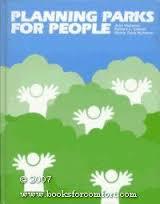
Planning Parks for People was written by John Hultsman, Richard L. Cottrell, and Wendy Hultsman and published by Venture Publishing, Inc. in 1987. This book takes an honest look at the outdoor recreation profession exposing mistakes that have been made and giving guidelines to aid in achieving better park design and recreation programs.
Chapter One – Setting the Stage describes the task of park and recreation professionals to provide the best possible experience for people coupled with their commitment to resource stewardship. Rather than blaming users for environmental damage that exists in parks and recreation areas, the book points out the poor planning, inadequate design, and lax administration that contribute to the problem. Good planning requires technical knowledge, common sense, and creativity in considering multiple alternatives for the design. Good design requires the park to be both functional and pleasing to the people who use the park for recreation as well as for those who maintain it. Throughout the book, the individual elements of recreation administration, including planning, design, programming, maintenance, construction, and management, are addressed.
Chapter Two – Tools of the Trade gives examples of problems created by inadequate planning and the types of knowledge recreation planners need to consider in their work. The issues to consider during planning include hydrology, soils, vegetation, topography, programming, administration, maintenance, user protection and safety, engineering, design psychology, and landscaping.
Chapter Three – Trails: Pathways for People examines the planning approaches for different types of trails as well as the people who use them. The basic considerations are zoning, design psychology, field design and construction, and administration. Some of the types of trails described include hiking trails, interpretive trails, biking trails, horseback trails, off-road vehicle trails, and trails designed for users with disabilities.
Chapter Four – Day Use Areas: Hosting Through Design focuses on design issues for boat ramps, beaches, picnic areas, visitor centers, and day camps. Good design will increase people’s enjoyment while decreasing the potential for hassles within the area.
Chapter Five – Special Uses for Special Users considers five types of use areas: living-history complexes, off-road-vehicle areas, wrangler’s camps, group camps, and military recreation complexes. These areas designed for special interest groups can be similar to other parks in design, but their specific facility and programming needs dictate additional considerations.
Chapter Six – Getting Serious about Play Areas encompasses play for all ages with considerations for safety, creativity, and scale in design. Various types of play equipment include stationary play equipment, manipulated equipment, and motion equipment. In creating play environments designers must balance safety, wearability, and cost factors into their designs. Types of play areas described include tot lots, playgrounds for older children, play areas for adults, and playcourts and playfields. Skill courses are also described for bicycle skills, archery skills, and fishing skills.
Chapter Seven – The Many Campgrounds We Really Have suggests that in general campgrounds must be large for three important reasons: management, users, and environment. Large campgrounds are cost-effective and provide for better maintenance, control, and programming. Specific types of campgrounds discussed include backcountry camps, the boatel or boat-camping areas, and sporting camps for fishing and hunting. Many design elements for campgrounds are explored.
Chapter Eight – Outdoor Recreation Programming or Yes, Virginia Camping Can Be Fun exposes several reasons why recreation programming has not been successful in campgrounds. It is suggested that campground programming should involve diversity, offering a broad spectrum of activity opportunities for all users. Types of programs include active programs that include court games and field sports; passive programs with board games, storytelling, and other “quiet” activities; interpretive programs that utilize nature hikes, lectures on forest products, and historical talks; skills programs such as campfire cooking and canoeing-skills; and nature arts and crafts activities. Program planning and preparation suggestions are given.
Chapter Nine – Miscellaneous Goodies touches on a few topics related to designing functional and pleasing parks and recreation areas. Signage, recreation, forage, wildlife, watershed management, and timber considerations are discussed.
Chapter Ten – Access to a Heritage: Roadblocks or Assurances challenges the readers to consider whether park planners, designers, and administrators have assured all Americans access to their outdoor heritage. Difficulties with students, their professors, and recreation curricula in the last several decades as well as professional issues and special interest groups have affected the outdoor recreation profession.1
- 1. Hultsman, John, Richard L. Cottrell, and Wendy Hultsman. Planning Parks for People. State College, PA: Venture Publishing, Inc. 1987.

